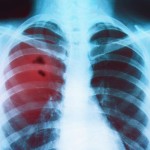Gangrene
30-09-2014 | 1581 View(s)
Gangrene is a condition that arises when a considerable mass of body tissue dies (necrosis) . This may occur after an injury or infection, or in people suffering from any chronic health problem affecting blood circulation. Gangrene is primarily caused due to reduced blood supply to the affected tissues that leads to cell death. Diseases like diabetes and long-term smoking increase the risk of gangrene. It can affect any part of the body but typic. Read more...
Frey’s Syndrome
30-09-2014 | 2813 View(s)
It is a neurological disorder resulting from damage to or near the parotid glands responsible for making saliva, and from damage to the facial nerve often from surgery . The symptoms of Frey's syndrome are redness and sweating on the cheek area adjacent to the ear. These symptoms generally appear when the affected person eats, sees, dreams, thinks about or talks about certain kinds of food which produce strong salivation. Observing sweating in. Read more...
Frost Bite
30-09-2014 | 1586 View(s)
Frostbite is a medical condition involving damage to skin and tissues due to extreme cold. Frostbite is most likely to happen in body parts that are far from the heart or those with large exposed areas to cold weather. The initial stages of frostbite are sometimes called "frost nip". A person with frostbite on the arms or legs may also have hypothermia (lowered body temperature). Frostbite can occur when skin is exposed to a temperature at or low. Read more...
Food Poisoning
30-09-2014 | 1438 View(s)
Food poisoning is illness that results due the consumption of food which is contaminated with pathogenic bacteria, viruses, or parasites. Most people get better without the need for treatment. In most cases, the food that causes the illness has been contaminated by bacteria, such as salmonella or E. coli, or a virus, such as the norovirus. The contamination of food can occur at any point beginning from growing, till processing and shipping of the. Read more...
Filariasis
30-09-2014 | 1398 View(s)
Filariasis is caused by several round, coiled and thread-like parasitic worms that belongs to the family filaridea. These parasites penetrate the skin either on their own or through the opening created by mosquito bites to reach the lymphatic system. The disease is caused by the nematode worm, either Wuchereria bancrofti or Brugia malayi and is transmitted by mosquito species Culex quinquefasciatus and Mansonia annulifera/M.uniformis respectivel. Read more...
Fibroids
30-09-2014 | 1712 View(s)
Fibroids are non-cancerous tumors that grow in or around the womb (uterus). Fibroids are sometimes known as uterine myomas or fibromyomas. Fibroids are made of muscle cells and other tissues that grow in and around the wall of the womb or uterus. The cause of fibroids is unknown. Risk factors include being overweight or obese and is mostly seen in African-American. They can grow anywhere in the womb and are named according to their origin: Int. Read more...
Epilepsy
30-09-2014 | 1767 View(s)
As per WHO, epilepsy is a chronic disorder characterized by recurrent seizures which may vary from a brief lapse of attention or muscle jerks, to severe and prolonged convulsions. The seizures are caused by sudden, usually brief, excessive electrical discharges in a group of brain cells (neurons). In most cases, epilepsy can be successfully treated with anti-epileptic drugs. Epilepsy is a chronic non communicable disorder of the brain that aff. Read more...
Enteric Fever/ Typhoid
30-09-2014 | 1405 View(s)
Enteric fever, also known as typhoid, is a common worldwide bacterial disease caused by the ingestion of contaminated food or water which contain the bacterium Salmonella enterica enterica, serovarTyphi. It is very common in India. Symptoms usually develop one to two weeks after exposure, and may be mild or severe. Symptoms include high fever, malaise, headache, constipation or diarrhea, rose-colored spots on the chest, and enlarged spleen and li. Read more...











